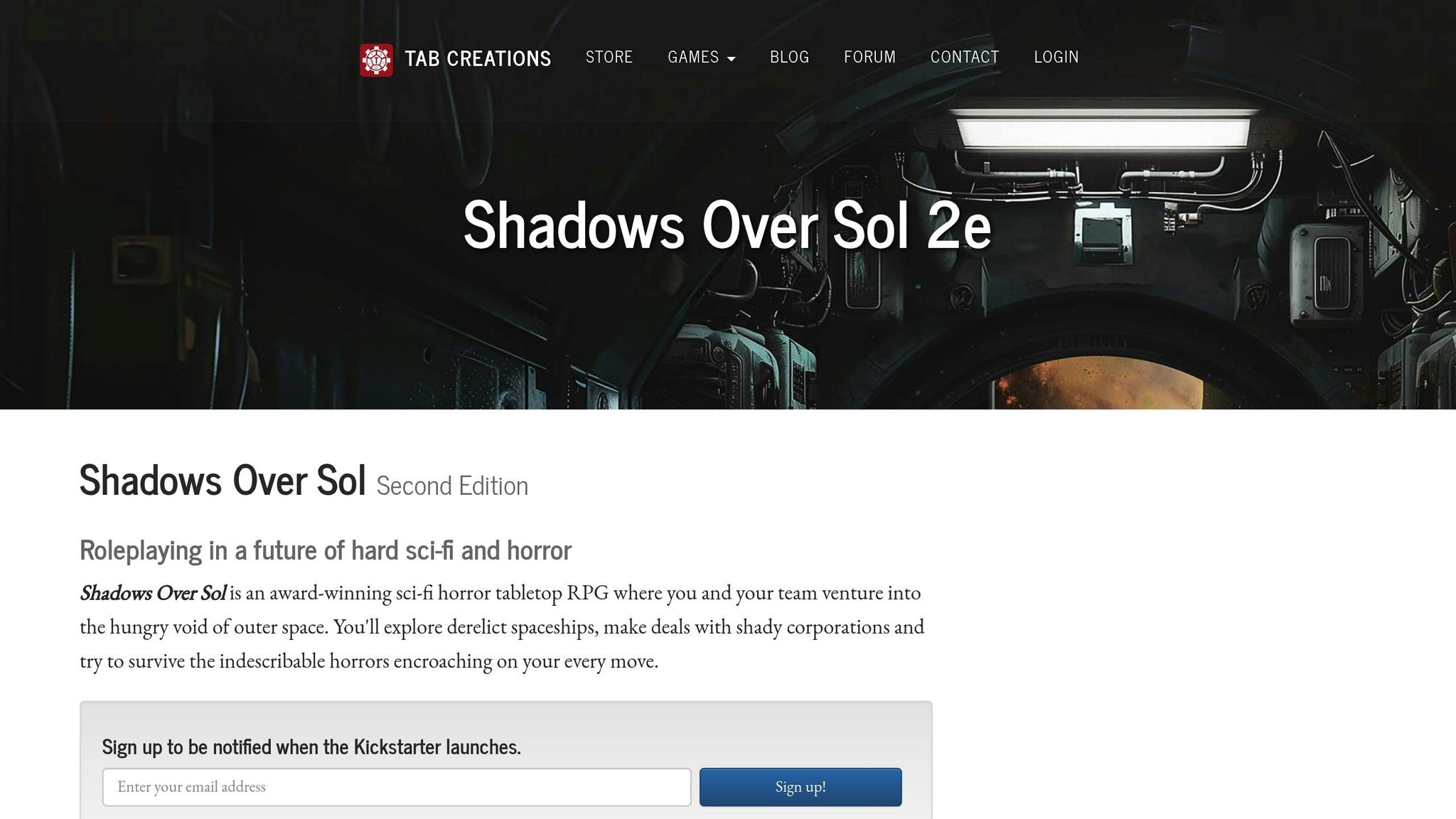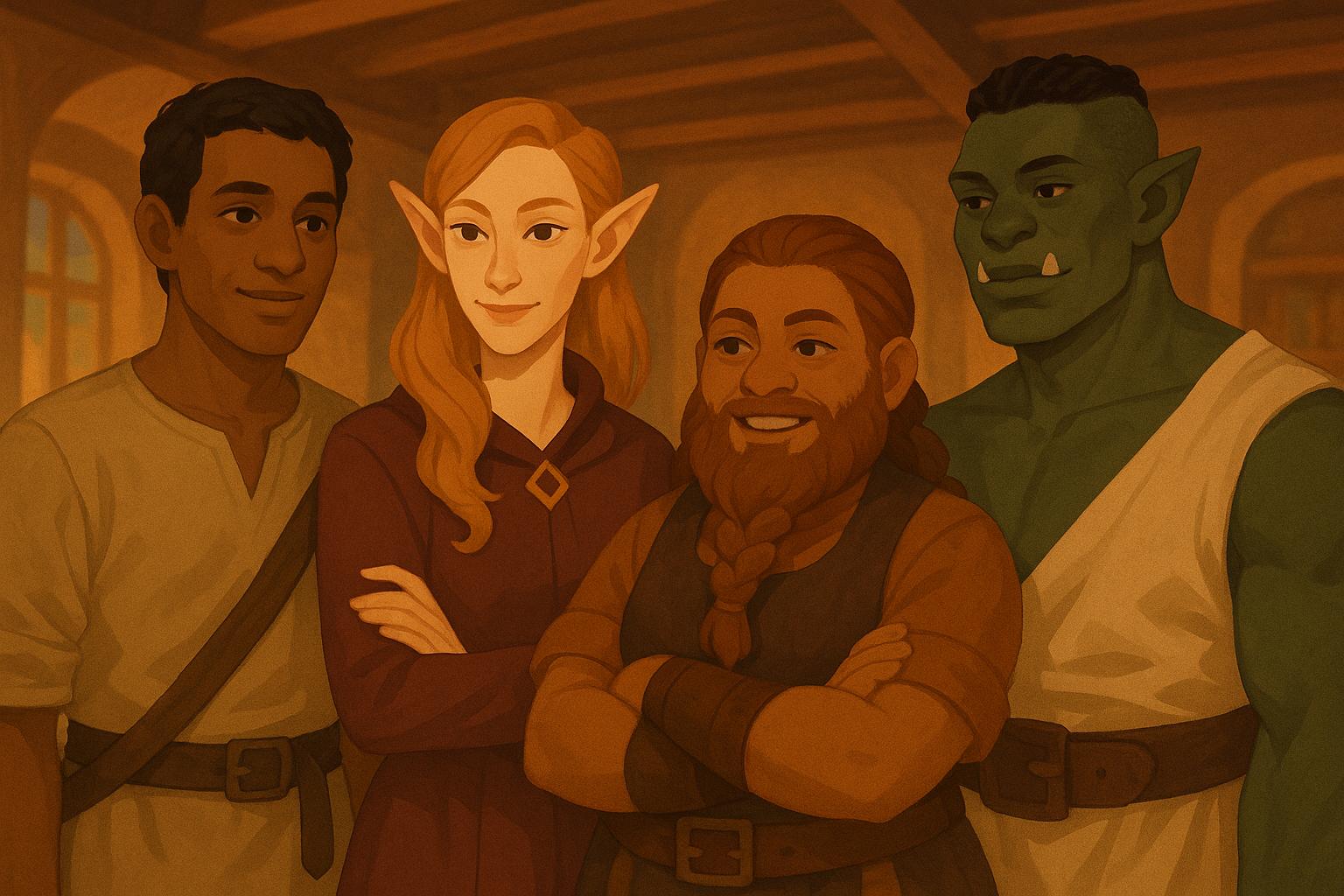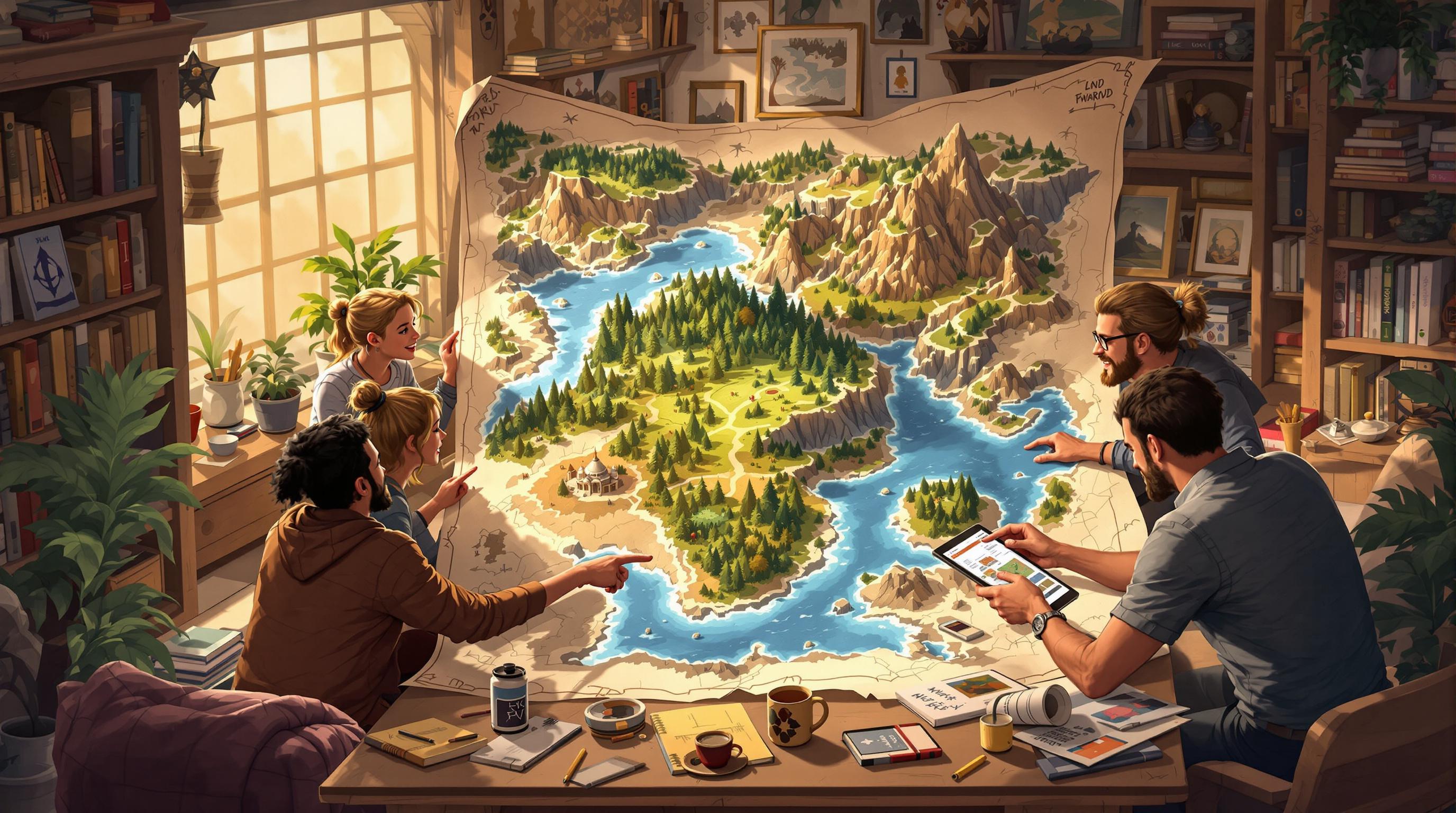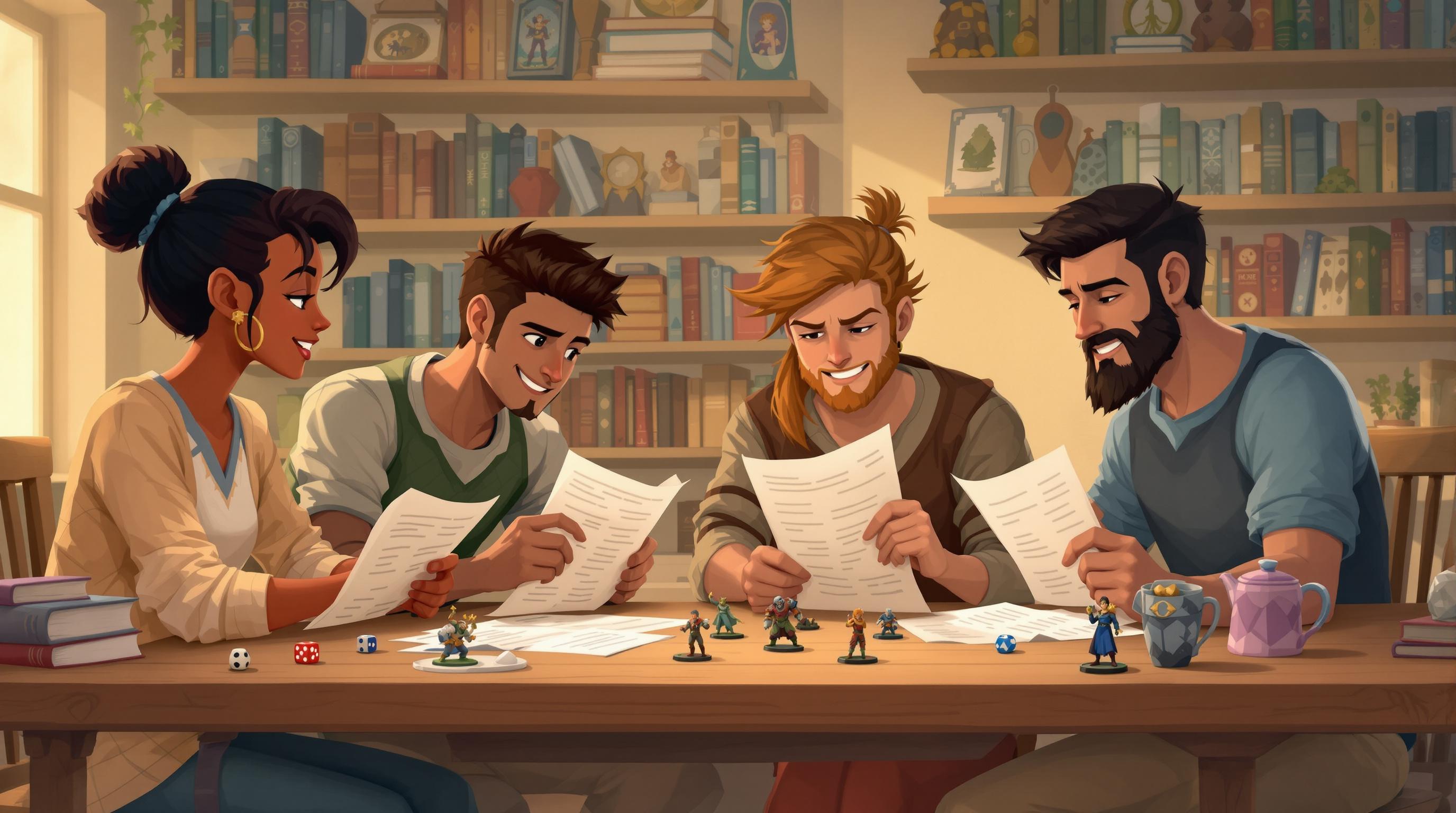Card-based resolution in tabletop RPGs replaces dice rolls with card draws to determine outcomes. Players use standard, tarot, or custom decks, offering a finite set of results that can be tracked and strategized. This creates a more tactical experience compared to dice, where randomness resets with every roll.
Key mechanics include:
- Finite Decks: Players can predict probabilities based on played cards.
- Hand Management: Strategic decisions arise from saving or playing cards.
- Deck Types: Standard decks are accessible, tarot adds thematic depth, and custom decks integrate unique game mechanics.
While cards enhance strategy and narrative integration, they can slow gameplay and reduce unpredictability compared to dice. Popular games like Shadows Over Sol and Faith: The Sci-Fi RPG showcase how card systems bring depth to storytelling and player decisions.
How Card-Based Resolution Works
Basic Card Resolution Process
Card-based resolution in tabletop role-playing games (TTRPGs) follows a simple and intuitive process that players can quickly pick up. When a player attempts an action, they draw one or more cards from a deck and compare the results against a target value set by the game master (GM). Think of it like rolling dice, except here, the card's value determines success or failure. High-value cards usually indicate success, while low-value cards might lead to failure or even complications.
What sets card-based systems apart is their ability to weave narrative elements into gameplay. Suits, for example, can introduce unexpected twists. Imagine a player trying to pick a lock and drawing a spade. Even if the card's value indicates success, the GM might decide a trap is triggered, adding a layer of tension to the scene. Some systems allow players to draw multiple cards and choose the best outcome, while others stick to the first card drawn. Regardless of the variation, the core "draw-and-compare" mechanic remains central to these systems. This approach also takes advantage of the deck's finite nature, encouraging players to plan ahead based on the cards already revealed. Now, let’s dive into the types of decks that make these systems tick.
Common Deck Types in TTRPGs
Standard playing cards are often the go-to choice for card-based systems. With their familiar layout of four suits and a clear hierarchy of numbered and face cards, they’re easy to understand and widely accessible - perfect for groups new to this style of play.
Tarot decks, with their 78 cards and the inclusion of the major arcana, bring a more dramatic and thematic flavor to the table. Drawing a major arcana card, which happens roughly 28% of the time in a single draw, can add a sense of gravitas to the game, making them an excellent choice for storytelling-heavy campaigns.
Custom-designed decks take things a step further by tailoring the experience to a specific game. These decks often feature unique artwork, game-specific effects, and mechanics that align perfectly with the game’s genre or story. They might include cards that trigger special abilities, provide narrative prompts, or even track character progression. Whether you’re using a standard deck, a tarot deck, or a custom one, the choice of cards significantly influences the feel and flow of the game. But the deck is only part of the equation - how players interact with it through core mechanics brings the system to life.
Core Card System Mechanics
One of the most important aspects of card-based TTRPGs is hand size. Games that allow players to hold five to seven cards add a layer of strategy, as players need to decide which cards to save for crucial moments and which to play for routine actions. This creates a constant push-and-pull between conserving strong cards and taking advantage of immediate opportunities.
Card values determine basic outcomes, while suits often add extra layers of gameplay. For instance, face cards might represent exceptional success or grant additional draws, while aces could act as automatic wins or wild cards. These mechanics add depth and variety, keeping players engaged.
Deck management is another strategic element unique to card-based systems. Unlike dice, where each roll is independent, a deck has a finite number of cards. Players can track which cards have been played, allowing them to estimate the odds of drawing specific cards as the game progresses. Many systems only reshuffle the deck when it’s nearly depleted, meaning every draw shifts the probabilities. For example, if most high-value cards have already been played, lower-value cards become more likely - a factor that savvy players can use to their advantage.
Some systems take this a step further by using the deck as a campaign timer. Completing a full cycle through the deck might signal a major story milestone, character advancement, or even a significant plot twist. This mechanic helps pace the game naturally, giving players a sense of progression without feeling forced or artificial.
Pros and Cons of Card-Based Systems
Benefits of Using Cards
Card-based resolution systems offer a unique edge when it comes to planning and player control. Unlike dice rolls, which rely entirely on chance, cards allow players to evaluate their hand and make strategic choices about when to play their strongest options. This creates a thrilling push-your-luck element, where every decision feels meaningful.
Players often face tough calls: Should they use a powerful card for a routine challenge now, or save it for a more critical moment later? This layer of decision-making adds a satisfying tactical depth to the gameplay.
In many card systems, the deck isn't reshuffled until most cards have been used. This means players can track which cards have already appeared, giving them a way to predict future possibilities and plan accordingly.
Cards also bring versatility to the table. They can do more than just resolve actions - they might track initiative, trigger special events, manage experience points, or remind players of unique character abilities. This multi-purpose functionality can streamline the game, cutting down on the need for extra tokens or tracking sheets.
These advantages highlight why card-based systems are appealing, but they also set the stage for understanding their challenges.
Drawbacks of Card Systems
Despite their strengths, card-based systems aren't without flaws. One of the biggest hurdles is their reliance on physical components. Shuffling, dealing, and managing cards can slow the game down, especially compared to the quick roll-and-resolve nature of dice. This issue becomes even more noticeable in online play, where digital card tools can interrupt the game’s flow.
The added complexity of managing a hand of cards can also be intimidating for new players. Keeping track of what’s been played, understanding suit effects, and handling other card mechanics might feel overwhelming at first.
Frequent shuffling and deliberate card management can also disrupt the pacing of fast-moving scenes. While some players appreciate the slower, more strategic rhythm, others might find it frustrating when the action drags.
Another drawback is the reduced element of surprise. Since players can often calculate their odds based on the cards they’ve seen, the wild, unpredictable swings that make dice rolls so exciting are less common in card-based systems.
Comparison Table: Pros and Cons
| Advantages | Disadvantages |
|---|---|
| Encourages strategic planning and resource management | Relies on physical components, which can slow gameplay |
| Gives players more control over outcomes | Can be overwhelming for new players due to complexity |
| Predictable probabilities by tracking played cards | Slower pace due to shuffling and card handling |
| Cards serve multiple roles (initiative, events, etc.) | Lacks the dramatic unpredictability of dice rolls |
| Push-your-luck mechanics add tactical depth | May disrupt pacing during fast action scenes |
| Custom decks can reflect character growth | Requires more setup and upkeep compared to dice |
At the end of the day, choosing between card-based and dice-based systems depends on what your group values most. If you enjoy thoughtful decision-making and a more deliberate pace, card-based systems can offer a rewarding experience. On the other hand, if you prefer quick resolutions and the thrill of unpredictable outcomes, dice might be the way to go.
Playing cards in TTRPGs
sbb-itb-b8b00a5
Card-Based TTRPG Examples
Card-based resolution systems bring a unique flavor to tabletop role-playing games (TTRPGs). Below, we’ll explore a few examples that showcase how different games incorporate card mechanics into their design.
Shadows Over Sol

Shadows Over Sol uses a standard 52-card poker deck in a way that seamlessly ties gameplay mechanics to character progression. When players perform actions, they draw cards to determine success or failure. Card values and suits influence outcomes, with higher values typically leading to better results.
But here’s the twist: the poker deck also tracks experience points. As players cycle through the deck during gameplay, they actively earn experience. This clever mechanic ensures that character progression happens naturally as part of the action, creating a sense of steady advancement. It also adds a layer of pacing to the game, as players can gauge their progress based on the cards they’ve drawn.
Faith: The Sci-Fi RPG

In Faith: The Sci-Fi RPG, each player manages their own personal deck of cards, giving them greater control over their actions compared to traditional dice rolls. Instead of relying on sheer luck, players can strategically choose which cards to play. High-value cards can be saved for critical moments, while weaker cards are reserved for less important tasks.
This personal deck system also ties into character growth. As characters develop, their decks can evolve too. Players might add new cards or modify existing ones to reflect their character’s growing abilities. This creates a tactile and visual representation of character development - players can literally hold their progress in their hands.
Action Cards System
The Action Cards System takes custom decks to a whole new level, introducing mechanics that wouldn’t be possible with dice. These decks often feature push-your-luck elements, where players can draw multiple cards to increase their chances of success but risk negative outcomes. Each draw adds tension, as players weigh the potential rewards against possible complications.
Custom cards in this system often serve multiple purposes. A single card might resolve an action, trigger a special ability, or introduce a narrative twist. These features allow the deck to shape the story dynamically, creating unexpected challenges or bonuses that keep gameplay fresh and engaging.
| Game | Deck Type | Player Control | Unique Features |
|---|---|---|---|
| Shadows Over Sol | Standard poker deck | Moderate (draw-based) | Deck cycling tracks experience points |
| Faith: The Sci-Fi RPG | Personal custom decks | High (hand management) | Individual decks allow for character customization |
| Action Cards System | Custom effect decks | High (risk/reward choices) | Push-your-luck mechanics with special effects |
These examples highlight how card-based systems can add depth, strategy, and creativity to TTRPGs. For more details, check out the TTRPG Games Directory.
Player Tips for Card-Based Systems
Card-based TTRPGs require careful planning since every card you play influences your future options. These tips build on the mechanics covered earlier to help you make the most of your deck.
Keep Track of Played Cards
Keeping track of the cards you've played can give you a strategic edge. Knowing what's left in your deck helps you adjust your approach. For instance, if you've already used high-value or special-effect cards, it might be time to play more cautiously.
A simple way to do this is by using a discard pile or a tracking sheet to monitor which cards have been used. This is especially handy in systems like Action Cards, where each player has a unique 24-card deck that includes six special-effect cards.
Manage Your Hand Effectively
Smart hand management is key. Save your strongest cards for critical moments when the stakes are high. For routine actions, rely on lower-value cards to preserve your best options for when they’re needed most.
Take Faith: The Sci-Fi RPG as an example. Players start each scene with seven cards, and running out of cards can lead to exhaustion until the next scene begins. In some cases, drawing extra cards depends on specific conditions, like matching environmental elements or aligning with your character’s traits. Understanding these mechanics can help you maintain a balanced hand and avoid running out of options too early.
Talk With Your GM About Rules
Clear communication with your Game Master is essential, as card-based systems often come with unique rules or house variations. Before you start playing, discuss details like how decks are reset or reshuffled, how discarded cards are handled, and any special rules for drawing or playing cards. For example, some systems reshuffle decks when only six cards remain, while others might do so at specific story points or when tokens are used.
It’s also a good idea to clarify any optional effects on cards so you can fully understand their tactical possibilities. These conversations ensure everyone is on the same page and can prevent confusion during gameplay.
| System | Hand Size | Reset Trigger | Important Rule Points |
|---|---|---|---|
| Action Cards | Varies by deck | Last 6 cards or token use | Special effect timing, custom edges |
| Faith: The Sci-Fi RPG | 7 cards/scene | New scene begins | Exhaustion rules, suit matching |
| Standard Systems | GM-dependent | Varies widely | House rules, optional effects |
Conclusion
Card-based resolution systems bring a fresh twist to tabletop RPGs, stepping away from traditional dice rolls and leaning into strategy and resource management. This approach adds a layer of tactical depth, giving players more control over their decisions while still preserving the suspense and unpredictability that make these games exciting.
One standout benefit is the boost to player agency. With cards, you can track what’s been played and decide when to use your strongest options. This creates a thrilling risk-reward balance, shifting the focus from random chance to thoughtful decision-making.
While there’s a bit of a learning curve, mastering card-based systems pays off with smoother, more strategic gameplay. Success often hinges on managing your hand wisely and staying in sync with your GM about the specific rules, as these systems can vary widely across games.
Whether you’re intrigued by the mechanics of a standard poker deck or the unique effects of custom-designed cards, these systems offer a mix of strategy and storytelling that’s hard to resist. The growing interest in card-based TTRPGs, especially among indie designers, shows that players are eager for alternatives to the usual dice-driven methods.
If you’re curious to explore, the TTRPG Games Directory is a great place to start. It lists a wide range of tabletop RPGs, covering different genres and play styles. While you’ll need to check individual game descriptions to find card-based options, the directory provides detailed insights into mechanics and themes to help you find the perfect fit for your group.
Switching from dice to cards might feel a bit unfamiliar at first, but many players find it a rewarding shift. Managing a hand of cards can bring a level of tactical depth and engagement that might be exactly what your gaming sessions have been missing. Why not give it a shot? You might just discover a whole new way to play.
FAQs
How does a card-based resolution system affect pacing and player engagement compared to using dice?
Card-based resolution systems bring a fresh and interactive twist to tabletop RPGs, offering a compelling alternative to traditional dice mechanics. Unlike dice, which are purely chance-driven, cards add a layer of strategy since players often have some control over their hand or deck. This allows for more thoughtful decision-making, as players can weigh their options before taking action, leading to a slower, more deliberate pace.
Cards can also enhance the tactile and interactive aspects of gameplay. Drawing, playing, or managing cards during a session can feel more engaging, especially for players who enjoy strategic choices or want something different from rolling dice. Whether it’s the added depth or the change in dynamics, card-based systems can bring a unique flavor to the table. Ultimately, the decision to use cards or dice depends on the game’s tone and what the group finds most enjoyable.
What are some tips for managing your hand effectively in card-based tabletop RPGs?
Managing your hand in a card-based tabletop RPG calls for a mix of strategy and careful planning. To get the most out of your gameplay, start by prioritizing your cards. Think about the current scenario and your character's goals - those high-value cards? Save them for moments when the stakes are high, like a critical challenge or a make-or-break situation.
It's also smart to plan ahead for future turns. Keep a well-rounded selection of cards - offensive, defensive, or utility - depending on the game you're playing. Burning through all your powerful cards too early might leave you unprepared for tougher situations later on.
If teamwork is part of the game, communicating with your group can make a big difference. Sharing your strategy or intentions lets the team align their moves, ensuring everyone's cards are used in the best possible way. Over time, you'll sharpen your instincts for when and how to play your cards, making every session more rewarding.
Are certain types of card decks better for specific tabletop RPG genres or themes?
Yes, the type of card deck you choose can have a big impact on the feel and flow of different tabletop RPGs. For instance, a standard deck of playing cards works perfectly for games that lean into luck or chance. On the other hand, a tarot deck can bring a mystical vibe or add a narrative twist, especially in fantasy or horror settings. Some games even come with custom decks that feature unique mechanics or artwork designed to match their specific themes.
Your choice of deck can also complement your play style. If you're into strategy, a deck with detailed symbols or complex mechanics might be your best bet. But if you want to keep the focus on storytelling and character development, a simpler deck might do the trick. Matching your card deck to the tone and genre of your RPG can create a more immersive and engaging experience for everyone at the table.


